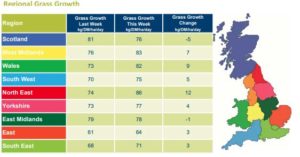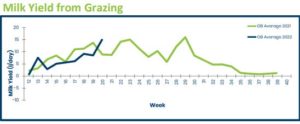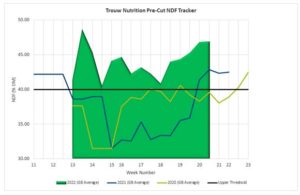Grass Growth
Grass growth continued to rise this week by an average of 2.2kg DM/ha/day across GB, averaging 77.8kg DM/ha/day and remains ahead of the 6-year average of 74kg DM/ha/day. Versus lasts weeks average growth, the North East has seen the greatest increase to an average of 86kg DM/ha/day, while Scotland saw a fall of 5kg DM/ha/day to average 76kg DM/ha/day.
Milk Yield from Grazing (MYFG)
Due to good weather and lots of silage activity, this week has seen a limited number of MYFG samples submitted. Of those samples which the lab did receive, average MYFG has seen a considerable rise to a GB average of M+15.3 litres/day because of increased potential DMI. It is important for farms to individually analyse samples as regular monitoring allows for optimised nutritional management and getting the most from the cheapest feed source in 2022.
monitoring allows for optimised nutritional management and getting the most from the cheapest feed source in 2022.
Managing Protein & Energy from Grass
Correctly managing energy and protein utilisation from grazed grass allows farmers to reduce reliance on additional complementary feed. Grazed grass is typically high in protein with ranges in excess of 15-25%. As protein from grass is highly rumen degradable and broken down by microbes to ammonia, energy is needed to convert the ammonia to available protein. Yet as energy is limiting from grazed grass and excess ammonia is common, this leads to energy diversion away from milk production. It is important to formulate supplementary feeds using NFEPB values to ensure a good energy and protein balance, often centred around being higher energy and lower protein which utilise high quality protein sources that provide good levels of rumen bypass protein. A perfectly balanced diet will have an NFEPB value of 0g/day, where positive values indicate excess protein and negative values indicate excess energy.
Pre-Cut NDF Tracker
Average NDF for the second half of this week has remained consistent with the beginning at 46.9% DM. High NDF grass risks lower energy first cuts, therefore, regular testing is important for each cut to ensure farmers are cutting at the correct time. A large range in NDF levels from 36.4 – 57.4% DM is reported, further highlighting the need for individual farms to analyse their grass to understand when to cut for optimal silage quality. The lowest average NDF levels were seen in the Northeast at 42.9% DM which is just above the target level. While the highest average NDF levels were seen in the Northwest at 47.9% DM. Average sugar levels this week have dropped below 10% DM, which leads to the risk of poor fermentation. If sugars are below 10% DM an additive designed for low sugar forage is recommended to ensure quality fermentation.

